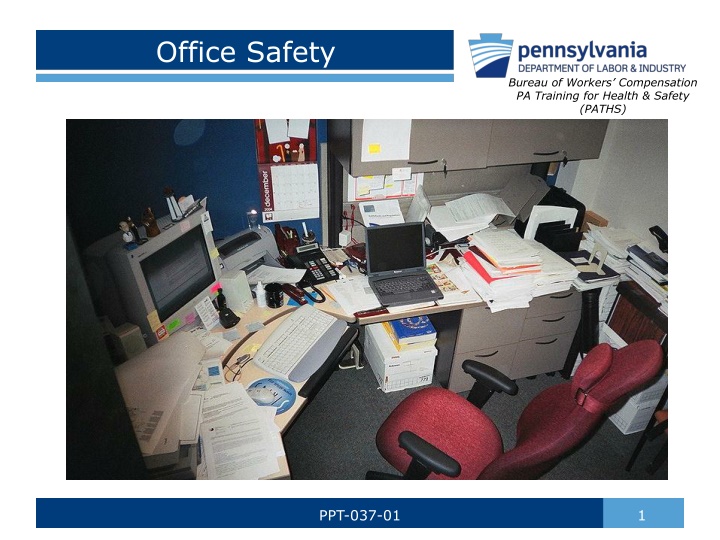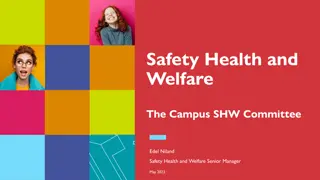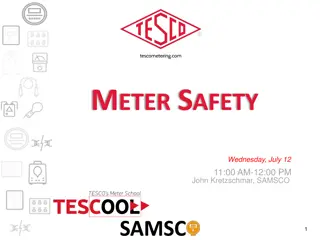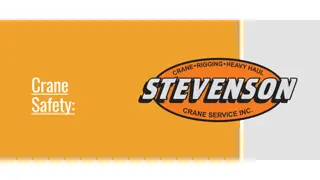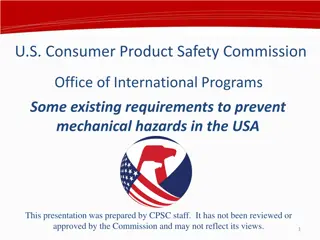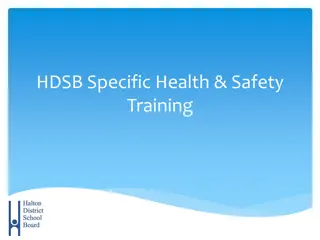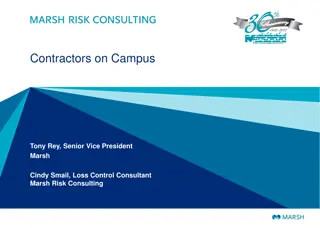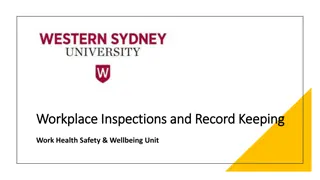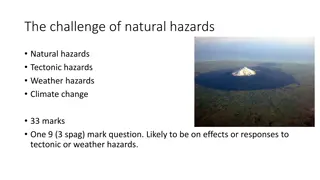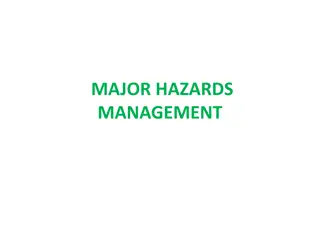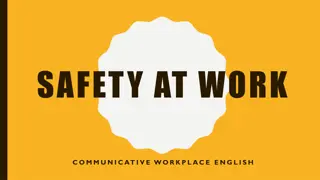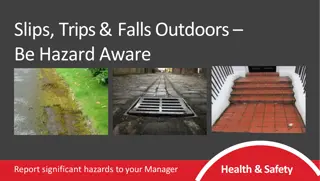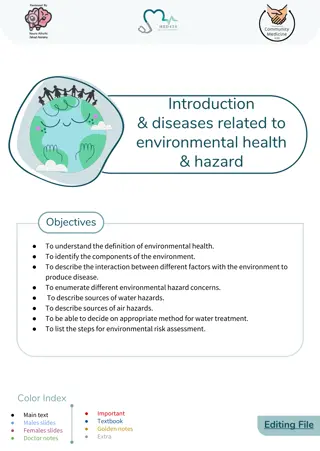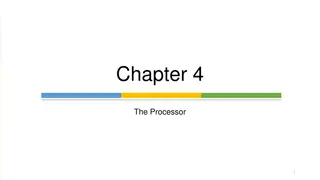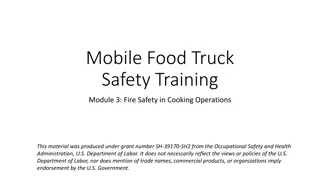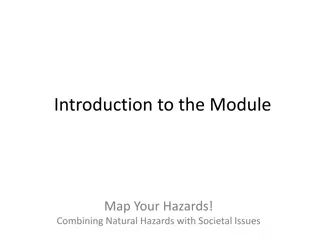Ensuring Office Safety: Hazards, Prevention, and Training
Today's offices are prone to various hazards that can lead to injuries and health issues. This presentation covers common office accidents, safety considerations, and preventive measures such as ergonomic practices, fall prevention, and emergency action plans. It emphasizes the importance of controlling and eliminating safety hazards in the workplace for a healthier and safer environment.
Download Presentation

Please find below an Image/Link to download the presentation.
The content on the website is provided AS IS for your information and personal use only. It may not be sold, licensed, or shared on other websites without obtaining consent from the author.If you encounter any issues during the download, it is possible that the publisher has removed the file from their server.
You are allowed to download the files provided on this website for personal or commercial use, subject to the condition that they are used lawfully. All files are the property of their respective owners.
The content on the website is provided AS IS for your information and personal use only. It may not be sold, licensed, or shared on other websites without obtaining consent from the author.
E N D
Presentation Transcript
Office Safety Bureau of Workers Compensation PA Training for Health & Safety (PATHS) PPT-037-01 1
Topics Leading Office Accidents Common Office Safety & Health Hazards Ergonomic Considerations Fall Prevention Emergency Action Plans Exercises that can be done in the Office PPT-037-01 2
Office Safety Offices of today are very different from the way they were 20 years ago. Many hazards exist within an office environment that can cause injuries and health problems. Slippery floors, open file drawers, poor lighting and machines that can emit noxious/hazardous gases are just some of the hazards that can be encountered. Appropriate steps need to be taken to control and eliminate hazards and safety issues. PPT-037-01 3
Leading Office Accidents Falls Strains and over-exertion Struck by or striking objects Caught in or between objects Foreign substances in eyes Burns from hot liquids/fires Electrical shock PPT-037-01 4
Common Office Hazards Ventilation Fire Hazards Illumination Electrical Equipment Noise Office Furniture Physical Layout Office Machinery Housekeeping Handling/Storage Hazards Exits/Egress PPT-037-01 5
Common Office Hazards Ladders Stands Stools Office Tools Copying Machines Video Display Terminals PPT-037-01 6
Ventilation Sources of office air pollution that can cause health problems include: o Natural agents (e.g. carbon monoxide, microorganisms, radon). o Synthetic chemicals (e.g. formaldehyde, cleaning fluids, cigarette smoke, asbestos). Adequate office ventilation system delivering quality indoor air and providing comfortable humidity and temperature is necessary. PPT-037-01 7
Ventilation If copying or printing machines used = exhaust ventilation system that draws particulates and gases away from breathing zone should be present. Office machines and ventilation system components should be checked and maintained on a regular basis. PPT-037-01 8
Ventilation-Safe Method? Why is this fan being used? Ventilation provided not adequate or not working? Could somebody get injured from this? Pencil holding up fan? Definitely! PPT-037-01 9
Illumination Poor lighting can cause: Glare Shadows Visual problems (e.g. eyestrain, fatigue, double-vision, etc.) Accidents/injuries PPT-037-01 10
Illumination Controls to prevent poor lighting conditions: Regular maintenance of the lighting system. Light-colored dull finish on walls, ceilings, floors to reduce glare. Adjustable shades on windows. Indirect lighting. PPT-037-01 11
Noise Noise can produce tension/stress. Sources of noise: Video display terminals. High-speed printers. Copying machines. Telephones. Human voices. Housekeeping/Maintenance work. PPT-037-01 12
Noise Measures to control noise: Place noisy machines in an enclosed space. Use carpeting, draperies, and acoustical ceiling tiles. Adjust telephone volumes to lowest level. Rearrange traffic routes within the office = reduces traffic within/between work areas. Use less noisy vacuums. Schedule Housekeeping/Maintenance services after work hours. PPT-037-01 13
Physical Layout Poor design/layout can lead to crowding, lack of privacy, slips, trips, falls. At least 3 feet distance between desks; 50 square feet per employee. Keep telephone and electrical cords/wires out of aisles and walkways. Keep office machines away from edges of desks/tables. Regularly inspect, repair, and replace damaged carpets. Place floor mats inside building entrances. PPT-037-01 14
Exits/Egress All exits should be at least 28 inches wide. Generally two exits should be provided. Exits and access must be marked as such. Means of egress should be free of obstructions and adequately lit (includes stairways used for emergency exit). All employees should be aware of exit locations and trained in proper evacuation procedures PPT-037-01 15
Fires Store unused records/papers in fire resistive files or vaults. Use flame-resistive materials. Smoke only in designated areas and use proper ashtrays. Fire extinguishers and fire alarm pull stations should be clearly marked and unobstructed. Flammable liquids should be kept to a minimum and stored in a metal cabinet. Fire doors should be kept closed at all times. PPT-037-01 16
Fires Do not hang anything from/on sprinklers, smoke detectors, heat detectors. Keep storage at least 18 inches from sprinkler heads. Report electrical hazards immediately (e.g. sparking outlets, damaged plugs, etc.). PPT-037-01 17
Handling & Storage Improper lifting = musculoskeletal disorders such as sprains, strains, and inflamed joints. Improperly stored objects can fall on people, cause poor visibility and fires. Materials should not be stored on top of cabinets. Heavy objects should be stored on lower shelves, stacked neatly. Store materials inside cabinets, lockers, or files when possible. PPT-037-01 18
Handling & Storage Do not block/obstruct fire extinguishers, fire alarm boxes, or fire suppression equipment. Identify and properly store flammable and combustible material. Do not block or obstruct aisles or walkways. Ensure shelves are secured to the wall to prevent tipping. Do not step on shelves or stand on chairs to reach items PPT-037-01 19
Ergonomic Considerations If you do same tasks with your hands over and over: try not to bend, extend, or twist hands for long periods. Don t work with your arms too close or too far from your body. Don t rest your wrists on hard surfaces for long periods. Switch hands during work tasks if possible. PPT-037-01 20
Ergonomic Considerations Take regular breaks from repeated hand movements: gives your hands and wrists time to rest. Don t sit or stand in the same position all day. Ensure your chair is adjusted so your forearms are level with your keyboard and you don t flex your wrists to type. PPT-037-01 21
Ergonomics - Computer Screen Top should be at or just below eye level and approximately 18-22 inches away. Chair Your back should be fully supported with feet flat on the floor or on a footrest. Knees should be approximately 90 degrees to floor when seated. Keyboard At a height so wrists are straight and elbows at approximately 90 degrees. Document Holder Place at same height and distance as screen. PPT-037-01 22
Ergonomics-Computer Eye Comfort Reduce glare on screen by controlling light from uncovered windows. Set screen at right angle to window if possible. Change Positions Frequently change positions to release tension on the body. Organize Work Area Keep frequently used items such as the telephone within easy reach. Exercise Take mini-breaks throughout the day to relieve muscle tension and reenergize the body PPT-037-01 23
Causes of Back Problems Heavy lifting from above the shoulders. Heavy lifting from below the knees. Twisting while lifting/carrying. Bending over at the waist. Carrying objects to one side. PPT-037-01 24
Lifting Avoid bending at the waist Squat down with your back straight and knees bent Grasp the object Bring it close to your body Slowly rise Let your thigh muscles do the lifting. PPT-037-01 25
Electrical Equipment Equipment must be properly grounded to prevent shock injuries. Ensure there are a sufficient number of outlets to prevent circuit overloading. Do not use poorly maintained or non-approved equipment. Do not drag cords over nails, hooks, or other sharp objects. Check equipment and receptacles to ensure there are no bare/frayed wires. Machines should be disconnected before cleaning or adjusting. PPT-037-01 26
Furniture Chairs should be properly designed and regularly inspected for missing casters, wobbly or cracked legs, loose parts. Do not lean back on a chair with your feet on a desk. Do not use a chair to move yourself from one area to another. Do not stand on chairs to reach for something. Open only one drawer at a time and only use the handles to close drawers. Do not locate file cabinets close to doorways or in aisles. PPT-037-01 27
Machinery Machines with nip points or rotating parts should be guarded to avoid accidental contact. Machines such as hole punches, paper cutters, and conveyors should be guarded. Fans must have substantial bases and blades must have guards that are no wider than inch. PPT-037-01 28
Ladders, Stands, Stools Always face the ladder when going up or down. Inspect ladders regularly to ensure they are in good condition. Never stand or sit on the top step of a ladder. Ladders should only be used when they are fully opened and the spreaders are locked. Ensure the ladder/stool used is tall enough to be used safely. Before using ensure ladders/stools/stands are on solid surfaces that are not slippery. PPT-037-01 29
Tools Office tools such as pens, pencils, paper, letter openers, scissors, and staplers can cause cuts, scrapes, punctures with resulting infections. Paper cutter blades should be closed when not in use and a guard should be in place. Always use staple removers and never test a jammed stapler with your thumb. Store sharp objects in a drawer or with the point down. Never hand a sharp object to someone point first. PPT-037-01 30
Photocopying Machine May use toxic chemicals, produce excessive noise, intense light, as well as being a source of indoor air pollution. Keep the document cover closed. Reduce noise exposure by isolating the machine. Place machines in well-ventilated rooms away from workers desks. Have machines serviced regularly to prevent chemical emissions. Avoid skin contact with chemicals and clean up all spills and dispose of waste properly. PPT-037-01 31
Video Display Terminals (VDT) Health hazards = radiation, noise, eye irritation, low back, neck, shoulder pain, stress. To minimize potential radiation exposure only use equipment for which you can obtain data on emissions. To minimize noise, VDT s should not be clustered; sound absorbent screens may also be used. Ensure VDT is not too close to operator (not less than 18-22 inches away). PPT-037-01 32
Fall Prevention Wear appropriate footwear = sturdy shoes with non-slip soles. These are much safer! Which shoes are safer? PPT-037-01 33
Fall Prevention Maintain a clear line of vision. Install convex mirrors around blind corners or cubicle walls to avoid collisions. Don t run electrical cords, telephone/computer wiring across walkways. Do not stand on chairs or other furniture to reach for something. Do not store boxes, files, or various other items in walkways. Use handrails when walking up or down stairs. PPT-037-01 34
Fall/Injury Prevention Close all file drawers immediately after use. Close the file drawer using the drawer handle, not your feet. Open only one file drawer at a time (to avoid causing cabinet to fall over). Never leave an open drawer unattended. Never open a drawer while someone is beneath it. Never climb on open file drawers. PPT-037-01 35
Emergency Action Plans Know the plan for foreseeable emergencies such as fires, hurricanes, tornadoes, etc. Know how to report emergencies. Know the location of the closest exit, fire alarm pull station, and fire extinguisher. Be familiar with emergency escape procedures and routes. PPT-037-01 36
Emergency Action Plans Know where to assemble after evacuation. Know the procedure used to account for all employees after evacuation. Know which employees are assigned rescue and medical duties. Know where emergency equipment is stored (e.g. flashlights, medical supplies, etc.) PPT-037-01 37
Office Exercises-Back Relaxer Bend down between your knees for as long as you can. Return to upright position, straighten, and relax. PPT-037-01 38
Middle/Upper Back Stretch Raise your right arm and grasp it below the elbow with your left hand. Gently pull your right elbow toward your left shoulder as you feel the stretch. Hold for five seconds. Do same for left side. PPT-037-01 39
Finger Stretch With palms down, spread your fingers apart as far as you can. Hold for the count of five. Relax and then repeat. PPT-037-01 40
Shoulder Roll Slowly roll your shoulders forward five times in a circular motion using your full range of motion. Then roll your shoulders backward five times with the same circular motion. PPT-037-01 41
Bottom Line There are many hazards associated with working in an office environment. Be aware of safety issues/hazards; report them, correct them. Realize an improper or careless act such as leaving a file drawer open can cause injuries. Think safety, act safely! PPT-037-01 42
Contact Information Health & Safety Training Specialists 1171 South Cameron Street, Room 324 Harrisburg, PA 17104-2501 (717) 772-1635 RA-LI-BWC-PATHS@pa.gov Like us on Facebook! - https://www.facebook.com/BWCPATHS PPT-037-01 43
Questions PPT-037-01 44
